PURPOSE This study aimed to identify the lower limb muscle activity based on direction prediction presence or absence and gender during side cutting in healthy college students. METHODS The study participants included 14 healthy males and females (8 males; 6 females). All participants ran at full speed for a distance of 12m, and side-cutting was carried out at 45 degrees in a randomly indicated direction and in a fixed direction. Simultaneously, data regarding vastus medialis, vastus lateralis, semitendinosus, and biceps femoris muscle activity of the dominant leg were collected using an electromyography sensor, and data regarding vertical acceleration were collected using an inertial sensor attached to the pelvis. A sync webcam was used for obtaining the initial contact of side cutting and the stance period time. During the 10 milliseconds (pre-activation) prior to the initial contact and 50% of the stance phase (loading phase), vastus medialis, vastus lateralis, semitendinosus, and biceps femoris average muscle activity and hamstring to quadriceps ratio included as variables. RESULTS During the pre-activation and loading phase, the vastus medialis muscle activity of the male group was higher in the unexpected condition than in the expected condition. Furthermore, hamstring to quadriceps ratio was confirmed to be lower under unexpected condition compared to under expected condition during on loading phase. CONCLUSIONS The study results suggest that the risk of anterior cruciate ligament injury may increase with side cutting under unpredictable conditions. It is expected to provide useful information for identifying factors related to knee injury in the general population.
PURPOSE This study investigated the associations between physical fitness and fall efficacy with thigh circumference in elderly women with osteopenia/osteoporosis. METHODS A total of 166 female participants aged 76.3±5.0 years with –1.0≥T-score of femur neck bone mineral density were voluntarily recruited from local community centers. The participants were classified as low 25%, middle 50%, and high 25% groups based on their thigh circumference. Physical fitness measurements, including strength, flexibility, aerobic endurance, and balance were measured with a standardized protocol. The Korean version of the fall efficacy scale (K-FES) was used to assess fall efficacy. Logistic regression analysis was used to estimate odd ratio (OR) of poor physical fitness and low fall efficacy according to thigh circumference levels. RESULTS In terms of physical fitness, the middle 50% group (OR=0.430, 95% CI=0.194-0.953) and high 25% group (OR=0.129, 95% CI=0.049-0.343) had significantly higher linear trend for poor physical fitness compared to the low 25% group (reference), (p<0.001). In fall efficacy, the middle 50% group (OR=0.279, 95% CI=0.119-0.656) and high 25% group (OR=0.100, 95% CI=0.036-0.275) had significantly higher linear trend for low fall efficacy compared to the low 25% group (reference) (p<0.001). CONCLUSIONS The current findings suggest that maintaining high thigh circumference via regular physical activity and diet may contribute to attenuation of decreased risk for poor physical fitness and low fall efficacy in elderly women with osteopenia/osteoporosis.
Purpose The study was designed to investigate the effects of 12 weeks of circuit training and L-tryptophan supplementation on physical fitness and metabolic syndrome. Methods Forty-one menopausal women were randomly assigned to one of three groups. i.e., combined circuit training and L-tryptophan supplementation group (CT+T: n=14), L-tryptophan supplementation group (T: n=14), and control group (CON: n=13). The subjects in CT+T exercised three sessions per week and took 3g of L-tryptophan per day for 12 weeks. The subjects in T took 3g of L-tryptophan per day for 12 weeks. The subjects in CON were asked to maintain their life pattern for the same period of intervention. Physical fitness and metabolic syndrome-related variables were measured at pre- and post-test. The data were compared by utilizing a repeated two-way ANOVA. Results Main results of the study were as follows: 1) Standing long jump, one leg standing with eyes closed, sit-and-reach, sit-up, and maximal oxygen uptake increased significantly in CT+T. 2) Body weight, body mass index, waist circumference, waist-hip ratio, fat mass, and percent body fat decreased significantly in CT+T. 3) Total cholesterol decreased significantly in CT+T. 4) Fasting plasma glucose (FPG), fasting plasma insulin, and HOMA-IR decreased significantly in CT+T. FPG and HOMA-IR decreased significantly in T. 5) Systolic blood pressure, diastolic blood pressure (DBP), mean arterial pressure (MAP), and rate pressure product decreased significantly in CT+T. DBP and MAP decreased significantly in T. 6) Number of metabolic syndrome risk factors decreased significantly in CT+T and T. Conclusion It was concluded that the circuit training and L-tryptophan supplementation would have positive effects on physical fitness and metabolic syndrome, and that L-Tryptophan supplementation would have positive effects on metabolic syndrome by improving insulin resistance and hypertension in menopausal women.
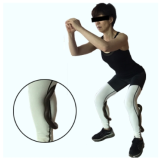
Purpose This study was designed to investigate the effects of weight-bearing exercise and CareRing treatment on cardiovascular responses, popliteal vein functions, and vascular elasticity of 30-40s women who had worked longer than eight hours a day in a standing position. Methods Thirteen subjects participated in 30 min of standing up treatment (STAND), weight-bearing exercise treatment (EX), and weight-bearing exercise with CareRing treatment (EX+RING). Each subject took part in the three trials repeatedly in a counter-balanced order and proceeded with a wash-out period of at least one week between the respective trials. Results The main results were as follows: 1) Significant reduction in EDV, no change in the diameter of popliteal vein, trend of reduction in blood flow of popliteal vein, and increased baPWV, indicating reduction of vascular elasticity of whole body, were shown in the STAND. 2) CO and EF increased significantly, and TPR decreased significantly in the EX. Blood flow velocity and blood flow volume of popliteal vein increased significantly, and baPWV decreased significantly from immediately after the treatment throughout the recovery phase in the EX. 3) HR, CO, and EF increased significantly in the EX+RING. Blood flow velocity and blood flow volume increased significantly in the EX+RING. Diameter of popliteal vein increased significantly immediately after the treatment and decreased significantly at 40 minutes of recovery. TPR and baPWV decreased significantly immediately after treatment compared to the STAND. Conclusions It was concluded that weight-bearing exercises would be effective in preventing venous or cardiovascular diseases occurred due to long-standing in 30-40s women, who are at high risk for such diseases. Furthermore, it would be more effective to combine pressure treatment with CareRing during weight-bearing exercises.

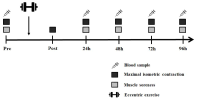
[Purpose] The purpose of this study was to examine the change of muscle damage markers after maximal eccentric exercise and to verify the difference of recovery according to ACTN3 gene polymorphism. [Methods] Fifty healthy males participated in this study. Subjects performed 25 times/1 set (total 2 set) maximal eccentric contractions of the elbow flexor muscles on a modified preacher curl machine with a between-sets rest time of 5 min. Maximal isometric contraction (MIC) was measured 6 times (pre, post, after 24 h, 48 h, 72 h and 96 h). Muscle soreness (SOR) was measured 5 times (pre, after 24 h, 48 h, 72 h and 96 h). Blood samples were collected 5 times (pre, after 24 h, 48 h, 72 h and 96 h). ACTN3 gene polymorphisms were identified using polymerase chain reaction (PCR). Data were analyzed using a 2-way repeated measure ANOVA and post hoc Bonferroni test. [Results] Analysis of ACTN3 gene polymorphism revealed the following distribution: 22% RR (n=11), 50% RX (n=25), and 28% XX (n=14). Individuals were classified into the RR homozygote group (n=11) and the X-allele group (n=39). MIC showed a significant difference between groups and interaction (p<.05). The groups differed significantly in MIC at 48 h, 72 h, and 96 h after exercise and the X-allele group decreased more than the RR homozygote group. The groups differed significantly in muscle soreness and interaction (p<.05). SOR in the X-allele group was significantly higher than in the RR homozygote group at 24 h after exercise. Although blood CK activity was lower in the RR homozygote group than in the X-allele group, but there was no significant difference between the groups (p>.05). [Conclusion] The RR homozygote group showed lower muscle strength reduction rate, muscle soreness and blood CK activity than the X-allele group. This indicates that RR individuals have a lower risk of exercise-induced muscle damage than those with an X-allele.

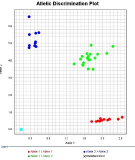
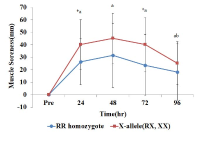
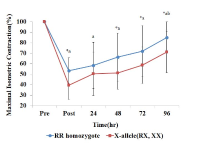
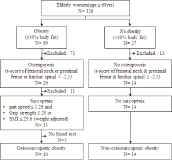
Purpose The purpose of this study were to assess physiological and biochemical characteristics in elderly women with osteosarcopenic obesity (OSO), and to analyze relationships among irisin, adipokines and bone metabolism markers. Methods 126 elderly women were selected and among them 10 women were classified into OSO group (76.9±5.2 yrs) and 14 women were classified as a NOSO group (72.9±5.6 yrs). Physique, body composition and bone mineral density were measured. Senior fitness tests were 30-s chair stand, 30-s arm curl, chair sit-and-reach, back scratch, 8-foot up-and-go, grip strength, and 2-min step test. Isokinetic muscle strength was measured by isokinetic dynamometer (Cybex 770, USA). Nutrition intake and physical activity were administered. Biochemical parameters including irisin, FNDC-5, leptin, adiponectin, CTx, 25(OH)D, osteocalcin, and PTH were measured. All data were analyzed by SAS 9.4. Independent t-test was applied to compare between OSO and NOSO groups. Multiple regression analysis was used. The level of significance was set at .05. Results The results of the study showed that there were significantly high for waist circumference, hip circumference, WHR, and BMI in OSO group compared to those of NOSO group. Higher results were also obtained for fat tissue and percent body fat but significantly low for lumbar bone mineral density. OSO group showed significant lower results for grip strength and 2-min step test compared to NOSO group. Peak torque, and relative peak torque at 60° were significantly lower for left and right knee flexion in OSO group. Protein intake was significantly low in OSO group, but no difference was obtained in level of physical activity between two groups. Irisin was significantly related to adiponectin, FNDC-5 and osteocalcin in explaining 35.2%, 81.5% and 92.1% of the variance, respectively. Conclusions This study shows that elderly women with OSO have higher results for physique and body composition parameters except body height. However, lower values were obtained for functional fitness, and isokinetic muscle strength. OSO may have more risks for metabolic syndrome, bone fractures, fall, lack of daily physical activity and limit of locomotion due to the imbalance of quadriceps and biceps femoris in non dominant leg. This study suggests that criteria and mechanism of OSO should be clarified by follow-up study.

Frailty in older adults is related to an increased risk for poor health outcomes including falls, disability, hospitalization and mortality. The purpose of this study was to determine the thresholds of a functional fitness associated with frailty for community-dwelling woman aged 65 or older. In this study, the National Fitness Award(NFA) items for elderly were utilized as the physical function and fitness testing for korean elderly women. The total of 444 community-dwelling woman completed the testings. Frailty status was classified by the Japan LTCI system ‘Kihon Checklist’ in the study. The prevalence of the frailty was 19.1% in the study. The frail elderly were older and showed higher obesity index such as weight, body mass index (BMI), percent body fat and waist circumference than the normal elderly. After adjusting for age and BMI which was related to frailty, fitness testing items were compared depending on frailty. As the result, the frail elderly showed significantly lower fitness levels in grip strength, 30-second chair stand test, timed up and go, figure-of-8 walk around two cones, and 2-minute step test than the normal elderly. When the fitness cut-off values were analyzed using the ROC curve, also, grip strength: 34.13%, 30-second chair stand test: 14 reps, timed up and go: 7.09 seconds, figure-of-8 walk around two cones: 30.88 seconds, and 2-minute step test: 93 reps. In addition, based on the cut-off values of each fitness item, the group with a low fitness level showed a 1.86 to 3.09 higher odds ratio of frailty than the group with a high fitness level, even after age and BMI were adjusted. In conclusion, these findings indicate that the fitness cut-off values in this study are fitness levels for preventing frailty of Korean elderly women and there will be a need for a large-scale study including subdivided fitness cut-off values for each age group and targets elderly men as well.